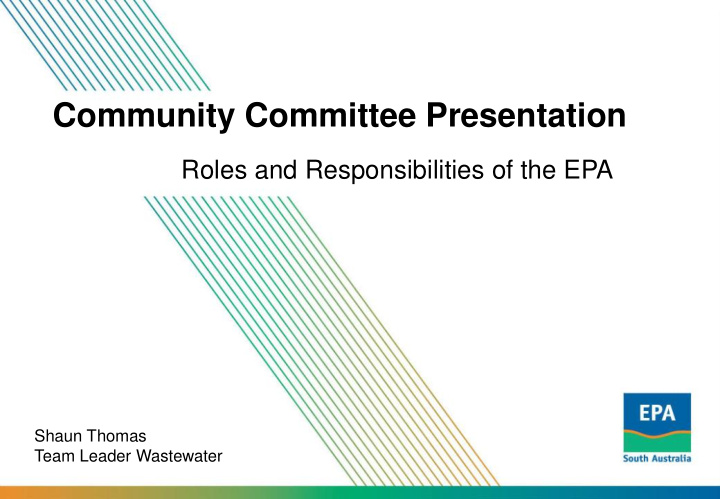



Community Committee Presentation Roles and Responsibilities of the EPA Shaun Thomas Team Leader Wastewater
Environment Protection Authority Administers the Environment Protection Act 1993 . • Environmental Authorisations (Licences) • Environment protection legislation – Environment Protection Policies – Codes of Practice – Guidelines • Section 25 - General Environmental Duty – reasonable and practicable measures to prevent or minimise environmental harm.
Environment Protection Act 1993 Environmental Authorisations (EPA licence) • Activities of Environmental Significance listed in Schedule 1 • A person must not undertake a prescribed activity of Environmental Significance except as authorised by an environmental authorisation in the form of a licence.
Managed Aquifer Recharge - Wastewater Licenced under 8(7) - Discharges to Marine or Inland Waters • Operations involving discharges into inland waters where the discharges — - contain chemical water treatments; and - the total volume of the discharges exceeds 50 kilolitres per day.
Approval Process • Typically – Development Approval required – EPA referred under Development Act (advice/direction) – EPA Licence granted • Managed Aquifer Recharge (MAR) – Development Approval not triggered – EPA Works Approval – permission to build the system
Works Approvals Application process – Wastewater MAR – Risk Management, Monitoring and Modelling documentation • Demonstrate that the MAR scheme will not cause unreasonable impacts on existing users, third parties and the environment. – National Guidance documents: • Australian Guidelines For Water Recycling: Managing Health and Environmental Risks (Phase 2) Managed Aquifer Recharge • ANZECC Guidelines
Works Approvals • Assessed by EPA and by DEWNR, advice sought from Health Department and from NRM. • Public Notification – by letter to adjoining residents – advertisement in the paper – minimum two week opportunity to provide comment • If approved the proponent is able to commence construction and EPA is obliged to provide a licence
Approvals - Licencing • EPA Licence – licence to operate the scheme • Similar application to Works Approval • Conditions applied to a licence to protect the environment and third parties – Risk Management and Monitoring Plans (based on the Australian Guidelines) – Managing risks from the water source, hydrogeology, operations – Injection pressures management – Set monitoring – continuous online and grab samples – Injection Criteria – aligned with the Water Quality Policy 2015 – Exceedances Register and actions – Annual report – exceedances and improvements • Referred to DEWNR for comment
Water Quality Policy 2015 • The Policy defines Harm to Waters • Outlines how Harm is to be minimised • Provides controls to prevent potential Harm – Discharges of pollutants – Management of wastewater lagoons • Outlines the environmental values of water resources
Water Quality Policy 2015 6 — Environmental values of waters (1) For the purposes of this policy, waters may have 1 or more of the following environmental values: (a) aquatic ecosystems; (b) recreation and aesthetics; (c) drinking water for human consumption; primary industries — irrigation and general water uses; (d) primary industries — livestock drinking water; (e) primary industries — aquaculture and human consumption of aquatic foods. (f) (2) The environmental values of waters are set out in Schedule 1.
Guidelines – Wastewater Lagoons Wastewater Lagoon – Referral to EPA under Development Act • Safeguard surface and groundwater resources • Guidance on reasonable and practicable measures – General Environmental Duty. • Clarity regarding criteria used for the assessment of wastewater lagoon proposals • Demonstrate legislative requirements – the Environment Protection Act 1993 and – the Environment Protection (Water Quality) Policy 2015. • Minimise the potential for site contamination
Guidelines – Wastewater Lagoons Lagoons must be designed and constructed: • Wastewater cannot intersect any underlying seasonal water table • Not liable to inundation or damage from flood waters • Contents of the lagoon do not overflow • Appropriately lined - minimise leakage • Where required - appropriate leakage detection
Questions?
Recommend
More recommend